Although she was not an official, government-sponsored war artist and did not contribute to the official war effort on the home front, Winifred Knights was profoundly impacted by the First World War, and her paintings – especially The Deluge 1920 (Tate T05532; fig.1) – presented opportunities to establish a critical stance on conflict, women and society. In this essay Knights’s activity during and immediately after the war will be considered alongside her engagement with the work of other artists who chose the war as their subject matter, specifically Paul Nash and Christopher R.W. Nevinson, among others at the Slade School of Art, London, and in Knights’s circle. The changing position of women in the art world and Knights’s response to the war in relation to representations of women will also be discussed as a means of understanding Knights’s contribution to the visual culture of conflict in Britain in this period.
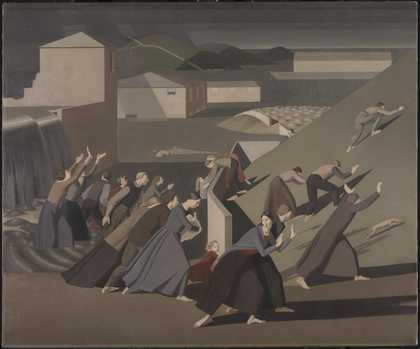
Fig.1
Winifred Knights
The Deluge 1920
Tate T05532
By the time war broke out, Knights was already an accomplished young artist with a bright career ahead of her. In spring 1916 she was working hard and reported optimistically to her family, ‘I am getting on nicely if you want to know and am improving rapidly (you may think I am suffering from swelled head but that is not so. I speak the truth when I say that there is a decided improvement in my drawing).’1 Knights’s family lived in Streatham in south London and she was enrolled at the Slade, where she studied through the first half of the war. Knights was keenly aware of the conflict’s effects – both in terms of the sheer loss of life and its associated anxieties, and of changing debates in the art world regarding approaches to war-related subjects – although she was not caught up in it in the same way that the war artists were. That said, in September 1916 some thirty-two bombs fell on Streatham, and in 1918 Knights wrote, ‘I have got to this state that I can’t let an aeroplane pass over my head without feeling terribly ill and shaky’.2
The key incident that art historian Sacha Llewellyn points to as Knights’s turning point for her traumatic memories of war was the Silvertown explosion of 19 January 1917 in the Messrs Brunner Mond Ltd TNT factory, which killed 73 people, injured 400 and could be heard for miles. Knights was on a tram travelling over Blackfriars Bridge when it happened and the incident, even at a distance, struck her with dread.3 After this Knights suspended her tuition at the Slade and relocated to Worcestershire for several months, citing a fear of air raids. When she returned, the keen and empathetic observation she brought to her work, and to her anxious witnessing of the conflict’s impact at home, was also applied to the Armistice. Knights wrote to her aunt regarding the Armistice in 1918 that ‘I just wished I could do a great drawing of that day and show you how it was. I have never seen such thousands of happy eyes. I must do a futurist picture of little pairs of smiling eyes mixed up with [an] omnibus sprouting bunches of little people and a man dancing the horn-pipe on a taxi-roof.’4
The Deluge as war art
Knights’s The Deluge does not offer a clear or straight narrative of the war. In fact, unlike her slightly earlier Leaving the Munitions Works 1919 (private collection), The Deluge does not deal explicitly with the war at all, taking instead the biblical subject of the flood that was imposed upon entrants to that year’s Rome Prize for which the painting was created and which it won.5 However, Knights’s treatment of the suffering of apparently innocent people and the pale, distant hulk of the disinterested ark in the painting’s background arguably constitute a war manifesto, one that uses the deluge story to offer difficult questions about who – if anyone – deserves to experience unbidden suffering.
Knights was not the only cultural figure to explore the biblical flood as a metaphor for the First World War. Llewellyn observes that politician Winston Churchill, poet Robert Bridges and filmmaker Michael Curtiz all compared the violent transformation of Europe and the war’s bloodshed to the deluge in Genesis.6 The gun-metal grey aesthetic of Knights’s painting, in conversation with passages of deep dirty greens and a pulsating, repetitive red, create a visual theme that connects metal and flesh. This palette and the uncompromising and innovative treatment of the ark as a sleek rectangular vessel work to undercut any potential for romanticism or sentimentality regarding this well-known biblical narrative. The reds draw the eye around the large canvas, reminding viewers that the vulnerable arteries of shared humanity and its frail flesh are ultimately powerless against the steely grey of uncontrollable ire, whether it be that of clashing nations and governments or that of the God of Genesis.
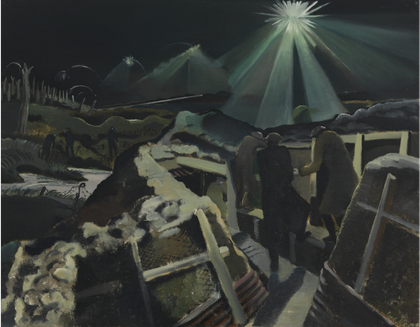
Fig.2
Paul Nash
The Ypres Salient at Night 1918
Imperial War Museum, London
© IWM (Art.IWM ART 1145)
Moreover, in Knights’s command of naturalistic figures, stylised dance-like gestures and cubistic geometrical forms, there is a resonance between her treatment of biblical horror and the reaction that Paul Nash’s art elicited from his viewers towards the end of the First World War. Following Nash’s solo exhibition The Void of War at the Leicester Galleries in May 1918, John Salis and C.E. Montague’s monograph British Artists at the Front: Paul Nash claimed that: ‘In drawing strange places so strangely, Mr. Nash contrives to bring back to the mind the strange things felt by men who were there, at moments of stress.’7 This can be seen in Nash’s oil painting The Ypres Salient at Night, completed in 1918 (fig.2); in this image, two trios of soldiers – hunched and furtive – are illuminated by shell-bursts above rickety trenches of different levels in a sodden landscape. Knights, too, bearing witness to war’s damage and highly familiar with the visual culture of war artists’ reactive and provocative work, including that of Nash, deployed this palette and set of stoic, simple and dark volumes across the expanse of the canvas in The Deluge in a way that suggests an uncanny emotional alienation – strange things with harsh consequences unfolding uncontrollably in a strange place.
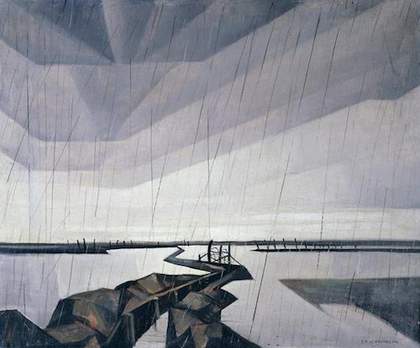
Fig.3
Christopher R.W. Nevinson
A Flooded Trench on the Yser 1916
Imperial War Museum, London
© IWM (Art.IWM ART 15124)
Nevinson, who is best known for images of gritty violence and pulsating militarised masculinity, created the etching A Flooded Trench on the Yser in 1916 (fig.3). Dark slashes representing heavy rain cut the scene into rough vertical fragments, emphasising the barrenness of the trench-filled land in which the absence of human life is haunting. The built-up, solid geometry of cloud meets the steady horizontality of the flooded trenches, with barbed-wire barricades in the middle and more distant zones of the composition suggestive of an endlessly receding depth. The work’s cubism unites earth and heaven in an uneasy union: the grey sky pulsing with light dominates a scene of stagnant water and passive earth. Knights’s own cubist-influenced work conflates cloud, water and earth, as if taking a cue from Nevinson’s heavy ruinous solitude and amplifying the urgency and tension with the addition of vulnerable people dressed in contemporary clothing, unequipped for monumental disaster, running for their lives.
War art, social change and masculinity
The war artists were not only key figures in British painting when they began their daunting commissions, but also rose to prominence for the impactful quality of their diverse images seen through the traumatic kaleidoscope of conflict. There was little glory in what many of them depicted, and it is often the more haunting, perilous or emotionally nuanced imagery from the period that is now better known. The tragic theatre of war was a strong theme, coming across particularly in paintings such as Mark Gertler’s Merry-Go-Round 1916 (Tate T03846). Yet many derided the artists who did not fight or assist directly with the efforts of the home front as ‘idlers’ and ‘workshys’, not being able to imagine that art itself could have a part to play, whether as war critique or war weapon. For instance, in 1917 the Fine Art Trade Journal reported acerbically, ‘For able bodied men and women to be employed in the production of mediocre pictures while the call is for service of pressing national importance is assuredly a criminal and disgraceful thing’.8
During the First World War the production of art shifted too – artists found it more difficult to source models, it was tougher to find steady flows of commissions, and while war artists were stimulated risk-takers, those who laboured with brush and canvas at home fared less buoyantly.9 The relationship between gender and art production also changed, and there was a melancholy kind of progress for the visibility of women artists in this period. More women’s work was exhibited, ultimately because fewer men were returning home from war.10 Indeed, in 1916 critics who attended the annual Royal Academy exhibition noted with alarm that instead of women artists constituting around a quarter of the participants, as was usual, the number had risen to a third.11 At the Slade itself there were over two hundred male students at the beginning of the war, which had reduced to a mere sixteen by 1919.12
The tragic yet necessary and creatively fruitful range of memorial art commissions continued long into the interwar period, and several women artists were directly involved in war work. Art historian Peter Cormack notes that Arts and Crafts artist and suffragette Mary Lowndes assisted in founding the Society of Women Welders, a trade union for women in munitions factories, and that the stained glass designer Margaret E. Aldrich Rope was a member of the Women’s Land Army.13 In 1919 Rope sketched an allegorical self-portrait The Arts of Peace… [and] of War, 8–9 May 1919 (UCL Art Museum, London) depicting her return to work from Britain’s rural agricultural landscape. In it she casts down tools as she strides defiantly into the left of the bisected composition, exchanging wrenches for brushes and transforming from the fashion of a farmer to one of an artist. A stained glass window depicting St George features a Gothic tower similar to the structure that overlooks the farming field she leaves behind. The implication is that her art and her war work are both labour for the good of the land, connected to the rhythms both of nature and of the remembrance of conflict. The canvas ahead of her, with paints scattered on the floor and a jar of water for brushes exactly as she left it, stands blank. It is full of the possibilities of a painter united with her vocation in peace time.
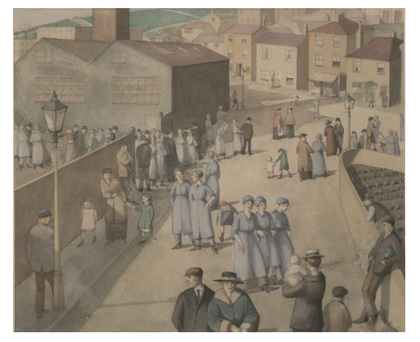
Fig.4
Winifred Knights
Leaving the Munitions Works 1919
Private collection
It was after the war, in 1919, that Knights truly came into her own at the Slade. In that year, having already established a reputation for quality and meticulousness in her work, she produced a relatively small, nearly square watercolour, Leaving the Munitions Works (fig.4). This is a constructed cultural memory of a relatively typical scene of female labour in wartime: as Sacha Llewellyn has pointed out, by 1917 approximately eighty per cent of the weapons used by the British Army were produced by women.14 Knights’s image positions the viewer gazing down onto a road between two low brick walls bordered by gas lamps. The cropped figures of a well-dressed working class couple front the scene beyond, which shows women munitions workers – each with a highly individual personality of her own and each in a standard-issue uniform – linking arms and conversing with one another. However still and serene the tone of the image may be in its execution and, on the surface at least, its mood, it is also an imagining of the kind of place at which the explosion took place that killed and injured so many at Silvertown in 1917. There is also the suggestion that leave-taking here is not only for this particular day, but one conducted en masse when women returned to the home and to their former means of earning a living, if any, after the war. In Leaving the Munitions Works the rhythm of houses and their gently gabled roofs, and the rolling hill in the distance that fills up the horizon almost entirely and enfolds the viewer within the immediate space of the skyless town, anticipate some of the compositional techniques that Knights would use months later when finalising her Rome Prize-winning painting The Deluge.
In June 1914 Nevinson and Filippo Tommaso Marinetti had produced ‘A Futurist Manifesto: Vital English Art’ in which they rounded on the ‘English notion that Art is a useless pastime, only fit for women and schoolgirls’.15 They were attacking what they perceived to be a philistinism regarding the visual arts in Britain, but the way in which they did so was through bitingly sexist means. Moreover, like fellow war artist Percy Wyndham Lewis, Nevinson was very interested in the links he saw between war and an aggressive style of masculinity – including the masculinity of war artists – in which violence itself could be the making and hallmark of a new and vigorous modern art for Britain. Nevinson wrote elsewhere that there could be ‘no beauty except in strife, and no masterpiece without aggressiveness’.16
In her book The Body in Pain (1985) philosopher Elaine Scarry meditates on war’s capacity to exacerbate what she calls the ‘body-state relation’. An injured body is the mark of the ‘literalness with which the human body opens itself and allows “the nation” to be registered there in the wound’.17 There is as much a meditation upon the inevitability of death and the anxiety of extinguished life as there is a vitality in the flight of the figures of The Deluge from one storm-torn region of Knights’s canvas to the other, racing towards the spectre of their own drowning. Knights’ work is meticulous and her vision took a great deal of time to emerge in each project. Her care in geometry, colour juxtaposition and blending of historical sources creates an effect of stillness that is not typically as energetic as the work of her contemporaries such as Stanley Spencer or Colin Gill. Rather than aggression, this is mathematics, observation and the pressures of history compressed to the point not of crystalline perfection but of emptiness – the construction of a surface that ultimately produces a zone free of vigour and soul.
The incomprehensibility of mass-scale suffering marked Knights’s painting and reactions to war as it did the everyday and creative lives of countless of her contemporaries. British politician Raymond Asquith wrote to his wife in 1916, ‘I agree with you about the utter senselessness of war … the suggestion that it elevates the character is hideous’.18 Knights was similarly terrified of war and angered by it, feeling a sense of despair coupled with a deep fear of destruction ripping through her own habitat, a fear that took root following the Silvertown explosion in 1917 and her subsequent move to the country, albeit temporarily. Increasingly throughout the First World War a crevice gaped between the reality of the front and the rhetoric of those who remained in Britain and sought to keep morale high. The ubiquitous and apparently uncomplicated chivalric imagery of the Happy Warrior was taken up with chilling results by art historian and critic Herbert Read, who wrote from the front about the loss of a friend: ‘Bloody saliva / dribbles down his shapeless jacket. / I saw him stab / and stab again / a well-killed Boche. / This is the happy warrior / this is he.’19 It is this pitiless tragedy that Knights’s work fought against and interacted with in its own way, both in the genre scene of Leaving the Munitions Works and the history-painting prowess of The Deluge.
The Deluge and the glorified dead
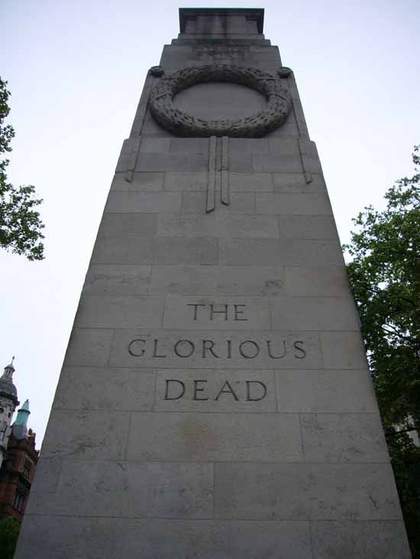
Fig.5
Edwin Lutyens’s Cenotaph of 1919, Whitehall, London
Photo © Adrian Welch / Isabelle Lomholt
In art and monuments produced immediately after the war, Englishness was presented in multiple forms, and the most striking national example is arguably Edwin Lutyens’s Cenotaph, erected on London’s Whitehall in 1919 (fig.5). Although initially a temporary structure made of wood and plaster, public support and an outpouring of public presence at the monument as an act of commemoration led to the Cenotaph becoming permanent, and it was reproduced in stark white stone. While the intricate geometrical symbolism and the commissioning process of the Cenotaph has been expertly covered by historians including Gavin Stamp and Allan Greenberg,20 it is productive to probe further into what was at stake in the initial inscription, ‘To the Glorious Dead’, and its later alteration to ‘The Glorious Dead’. Prime Minister David Lloyd George had suggested the original wording, and it was frequently mentioned in press reports of the July 1919 unveiling; Knights would have known it well. The final iteration of the Cenotaph design eliminated the sense of the monument as a gift through the removal of the word ‘To’. The effect is a resounding proclamation regarding the purpose of the Cenotaph. It was not erected for the glorious dead, but rather stands in for and embodies them. With this emblem of classical purity and stark stoicism positioned in the heart of Westminster, the nature of ‘glory’ in relation to grief and loss was brought into sharp focus.
Knights’s figures in The Deluge are sleek and vibrant yet unidealised in their features’ specificity. They are incarnations of humanity seeking the glory of God and yet not finding it, finding only death instead. They question the notion of death as ‘glorious’ at all, their beauty subsumed by rising water. As such, The Deluge can be productively considered as an ambiguous war memorial. The dead are not ‘glorious’ as in Lutyens’s Cenotaph; are not listed and named, as in the memorial plaques and monuments that were unveiled around the country and in Europe throughout the interwar years. The dead are submerged; suffering persists; few are saved. In its anxiety and energy, The Deluge is a plea for peace amid the rising waters of humanity’s own violence and tragedy, which even in 1920 had not yet receded.
